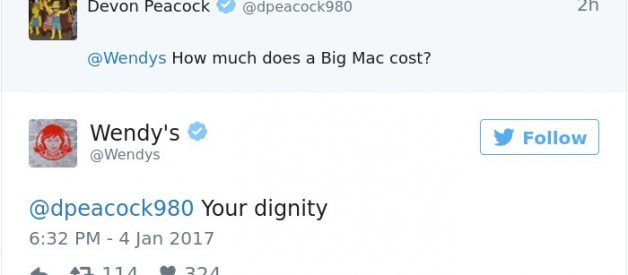Marketing and social media lessons learned from Wendy?s brilliant Twitter team
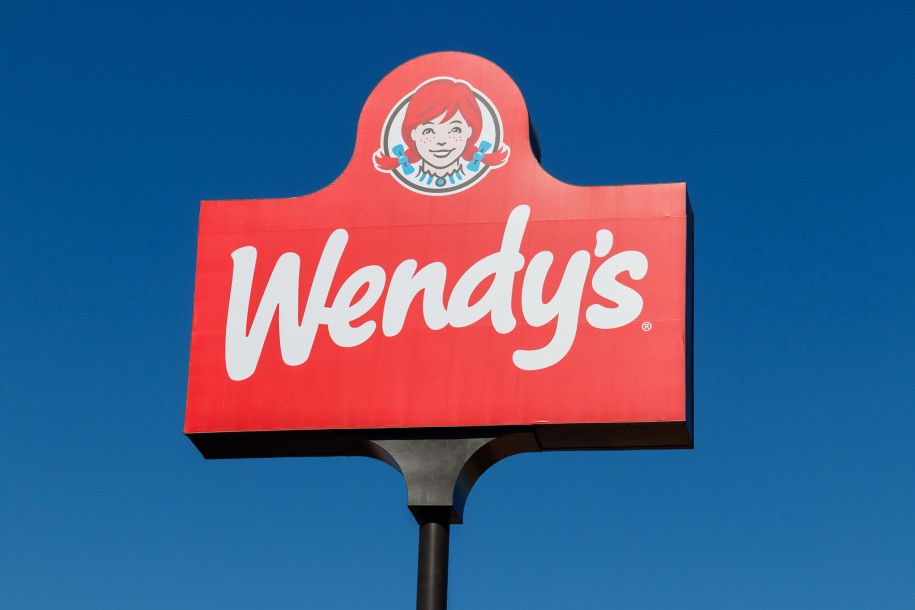
Social media ? especially Twitter ? is a right-out minefield. Brands are eager to stand out in a crowded marketplace, but it?s far from easy.
There?s an ever-growing list of boxes to tick as we, consumers, grow wiser about what we accept in our feeds. In 280 characters or less, brands have to prove they?re funny, relatable, don?t take themselves too seriously, have good products to sell us and are down with pop culture. Brands try, but very few of them truly succeed.
Yet, those who get it right can achieve massive payoffs. The potential impact is enormous. Here?s a quote by Jeff Bezos about Amazon?s customer-obsessed culture that illustrates this very well:
?It used to be that if you made a customer happy, they would tell five friends. Now, with the megaphone of the internet, whether online customer reviews or social media, they can tell 5,000 friends.?
Bezos? insight is spot-on. The power has completely shifted to the hands of the consumers indeed.
Good social media is a high-risk, high-reward kind of game. As a result, the majority of corporate Twitter is painful to look at and comes across as insincere. Basically, being consistently funny is hard.
Luckily, there are exceptions.
Enter Wendy?s. They?ve hit the trifecta of humor, brand awareness, and authenticity. For years, Wendy?s had this quirky and out-of-the-box way to drive interactions on social media. We know the end goal was to sell burgers, but the tweets were so funny and good, most people didn?t even care.
Simply put, Wendy?s wasn?t afraid to drop the mic. The brand ? represented by a sweet-faced, red-haired girl ? roasted fans, cracked jokes and called out competitors. She also promoted her menu, gave away free food, and even dabbled in the occasional rap battle.
Its funny persona led to Wendy?s snagging the #1 spot on Fast Company?s Most Innovative Companies list of 2019 in the category of Social Media. Wendy?s tweets were engaging, highly clever, and at times, laugh-out-loud funny.
Just to illustrate what we?re talking about here, here are a couple of Wendy?s sassy tweets that I particularly liked. As you can tell, I especially enjoy their hilarious tweet roasts of other burger chains (McDonald?s, anyone?):
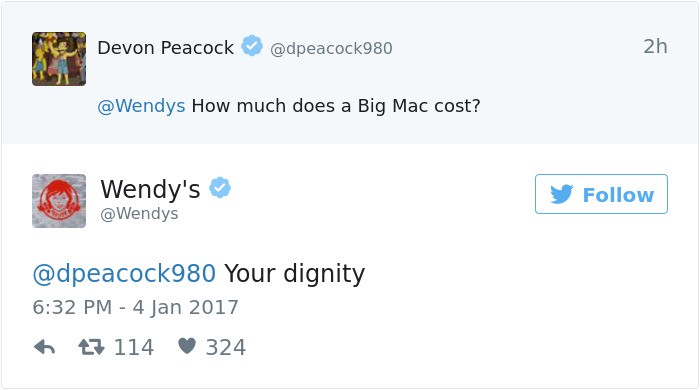
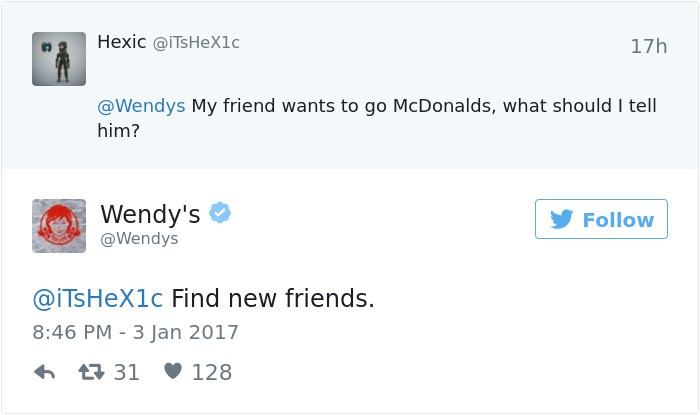
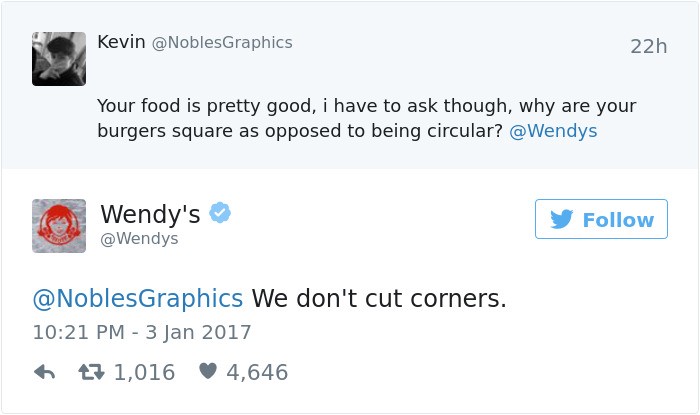
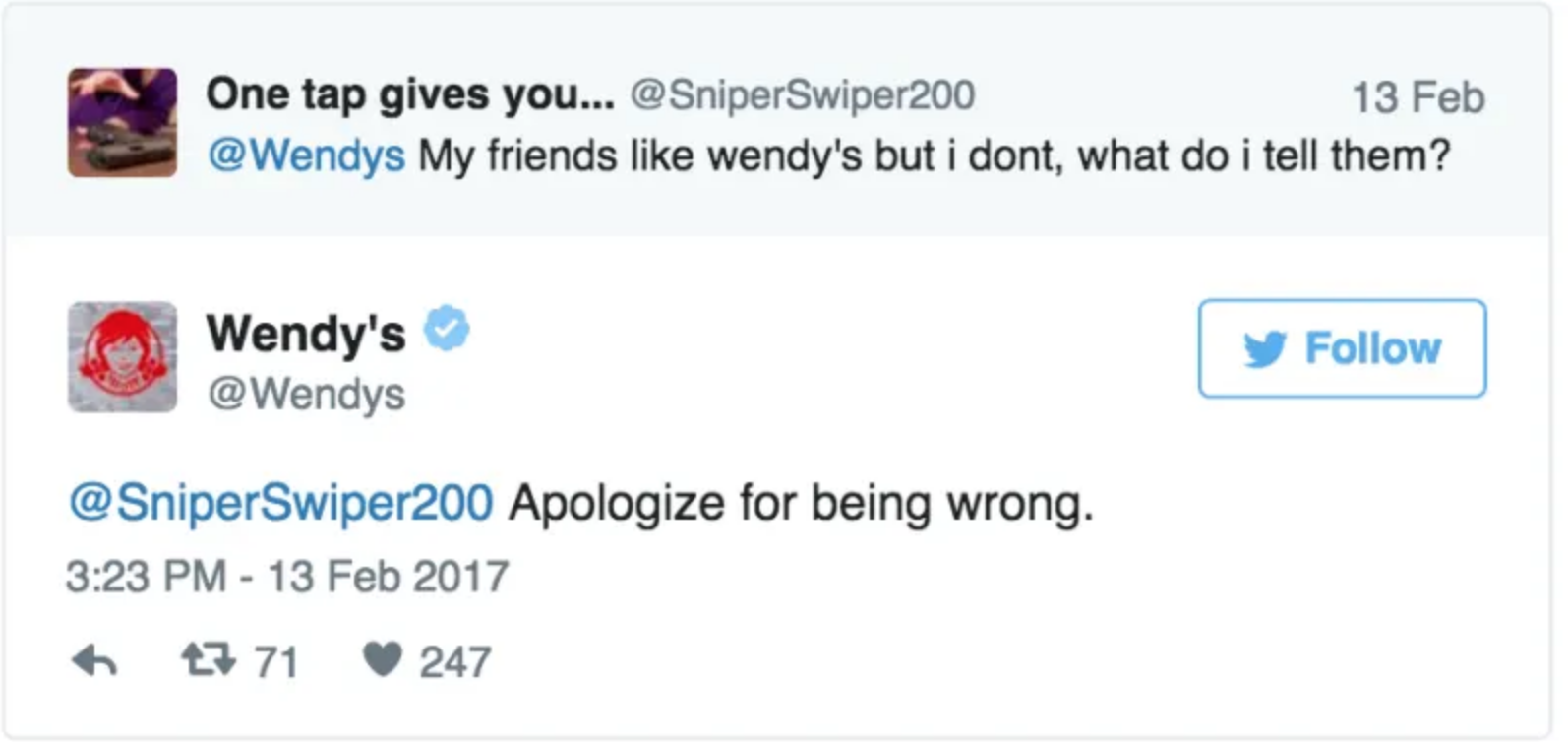
By the way, remember when some guy online won a years? worth of free nuggets after he tweeted to Wendy?s? Carter Wilkerson asked Wendy?s for some free nuggs, which resulted in him becoming the author of the most-retweeted tweet in Twitter?s history. His quest for chicken nuggets, #NuggsforCarter, got retweeted a staggering 3.4 million times!
Next, after a rap battle with rival Wingstop, Wendy?s in March 2018 introduced a five-track mixtape titled ?We Beefin??? to some good reviews. One track even topped Spotify?s global viral chart!
In short, social media has proved to be a game-changer for Wendy?s in an imbalanced marketing world. Because of top rival McDonald?s multi-billion-dollar marketing budget, it can ??outshout?? Wendy?s by three or four times. Social media tips the scales back in Wendy?s direction.
Disclaimer (!)
Now before I get into three social marketing lessons any business can learn from Wendy?s team, here are two important warnings. A disclaimer, as you will.
Remember Wendy?s target audience.
The tweets and roasts were funny because their Twitter marketing is geared towards young people who enjoy seeing Twitter beef, which fits perfectly for them. However, internet trolling is highly generational and may not be as well received by every social media user.
And then again, even Wendy?s messes up from time to time. In 2017, a meme on Twitter drew the ire of human rights groups after Wendy?s posted a drawing of Pepe the Frog, a cartoon that?s become a popular anti-Semitic character among hate groups.
They don?t sell a ?serious? product; they sell food.
Wendy?s sells food; cheap, fast food that they?ve sold in roughly the same way for the past 50 years. They had the room for some humor because this is a well-known brand that sells burgers and fries, not architectural materials or medical devices. If you?d find out your insurance company or law firm would be roasting people on Twitter, things would look a lot different.
In the end, social media will never be one-size-fits-all. While the fast-food chain may be ?the bold friend you want to go to lunch with,? this tone is authentic to Wendy?s and isn?t a silver bullet for all brand personalities. Each brand has to find what?s right for them.
That said, there are some great lessons to be learned from Wendy?s social media success.
Lessons
While Wendy?s has a professional (and very funny) team supporting the brand, all small businesses can adapt the strategies they use. They?ve created a brand that?s known for their exceptional responses, both customer service-wise, and roast-wise. They maintained this authentic and distinct voice in a very consistent way. At the end of the day, this comes down to consistently giving customers what they want and showing that you care.
1) Be incredibly responsive.
Reply rate has been the secret sauce of Wendy?s Twitter strategy. 78% of the people who tweet to any brand expect a reply within one hour. In 2017, Wendy?s replied to over 20K tweets in an average of 15 minutes per tweet! Their social media team is definitely on the go, engaging as soon and as witty as possible to keep their customers happy.
Although most funny jabs are left behind (more on the reasons behind that later on), their responses have remained really quick, and while they clearly address any and all tweets possible, they make sure to respond quickly (and seriously) to users who have complaints. They never let a complaint go unanswered, and they make it clear to the user that they want to resolve any issues. If it takes them a little while to answer, they?ll even apologize for the delay.
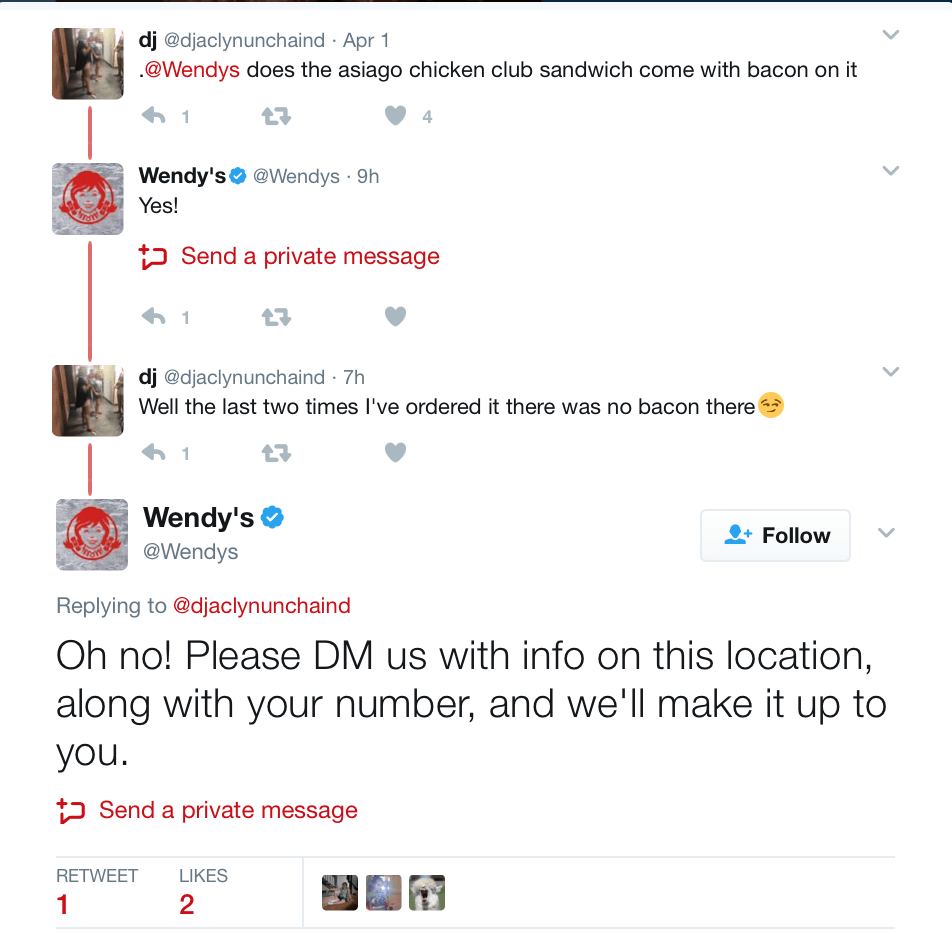
To sum up, the first major lesson that all (small) businesses can learn from Wendy?s is to always be extremely responsive. Thanks to the immediacy and constant accessibility of the internet, people want responses to any and all interactions, and they want them now. And Wendy?s is ready. Are you?
2) Consistency is key.
Wendy?s posts frequently, and while they use a variety of different content types, everything on their feed makes sense when looked at as a whole. This long-term consistency allows them to keep engagement high and keep their momentum going. This is something many brands fail to do; they?ll have one great campaign, get a ton of attention, and then it all kind of tapers off.
Wendy?s, however, went in ready to maintain what they were working on ? and it?s paid off. From their 1984 ?Where?s the Beef?? campaign to their more recent campaigns on Twitter, Wendy?s has fashioned an image of itself as a humorous, approachable brand that doesn?t take itself too seriously and wants to have fun with their customers. With this ?fresh, never frozen? approach to customer engagement, Wendy?s offers a customer experience that?s as satisfying as their burgers and as desirable as a year?s supply of chicken nuggets.
3) Make it relatable.
In an age of social marketing and the power of word-of-mouth, being liked boils down to being relatable.
In an interview with Entrepreneur, Wendy?s chief marketing officer Kurt Kane explained customers associate their brand with real people, so it had to act like a real person on Twitter. ?The biggest thing we decided was to stop advertising to people and to start having a conversation with people,? Kane said.
Think about it: today, social media prompted many more of us (not just millennials!) to befriend our favorite brands. In fact, it?s one of the few environments where users really want to consume branded and sponsored content. With marketing embedded in environments where customers communicate with friends and family, they naturally gravitate toward those they relate to most.
So what?s Wendy?s new strategy to remain fan favorites? Well, they?ve made their mark as Twitter?s attack dog, and all there?s left to do now is to cement those relationships. After all, that?s what good brand marketing is about? feeling like a friend.
While their savage roasts and snarky callouts to the competition might not have resulted in tons of extra restaurant visits, it certainly did help build a loyal following. And it allowed the company to continually showcase how it?s different, whether it?s with a playful voice or with the burgers and fries it serves in stores.
In short, Wendy?s isn?t out to roast you anymore. They?re here to be your best friend. And more than perhaps any other brand, they?re the ones who seem to have the strongest relationship with their true fans, choosing to cater to a few rather than the masses.
Well done, Wendy?s.
